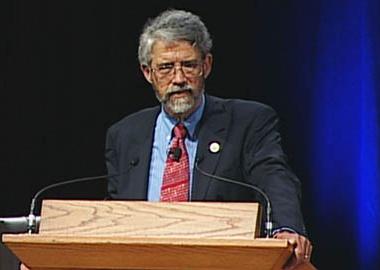 It’s no exaggeration to say John Holdren’s job involves tackling the most critical issues of our age: economic recovery and growth, health care, energy, climate change, global pandemics, national security, ecosystem preservation…the list goes on. As President Obama’s science and technology advisor, Holdren leverages the resources and collective acumen of the nation’s researchers and innovators to address these complex and urgent matters. At an MIT AeroAstro hosted event, Holdren makes the case that aerospace science, technology and education will provide a “crucial contribution to and driver of many relevant capabilities” the U.S. will need to meet this century’s challenges.
It’s no exaggeration to say John Holdren’s job involves tackling the most critical issues of our age: economic recovery and growth, health care, energy, climate change, global pandemics, national security, ecosystem preservation…the list goes on. As President Obama’s science and technology advisor, Holdren leverages the resources and collective acumen of the nation’s researchers and innovators to address these complex and urgent matters. At an MIT AeroAstro hosted event, Holdren makes the case that aerospace science, technology and education will provide a “crucial contribution to and driver of many relevant capabilities” the U.S. will need to meet this century’s challenges. He cites in particular the relevance of “nitty-gritty things like infrastructure” in aerospace research and industry -- -- including military and civilian satellites enabling earth observation and tracking for national security purposes or weather forecasting. These technologies engender “spin-offs into other domains of the economy, health care and the environment.” In addition, the Hubble Space Telescope and the International Space Station are inspiring students to pursue science and engineering. Holdren hopes these young researchers will eventually pave the way to clean energy and a revitalized economy.
President
Obama has put science and technology “front and center,” and these priorities are reflected in a budget that provides big boosts for science, and also for transportation infrastructure and applied energy technologies. Government agencies are trying to resolve the “budget-vision disparity” in the space program; air traffic control problems resulting from the steady expansion of civil air traffic; and the problem of greenhouse gas emissions and fuel economy of aircraft. But Holdren worries about maintaining the administration’s ambitious space and aeronautics agenda, in the face of ballooning government programs, and ongoing military commitments. Aviation and space communities must work together across government, industry and academic sectors to overcome these obstacles -- “a giant leap requiring giant partnerships.”
A group of aerospace leaders respond to Holdren’s talk. Michael Bair notes that the aviation industry is growing faster than GDP, but challenged by “an awful business model” and an expanding carbon footprint. He sees hope in fuel efficiency improvements, especially biofuels, and new air traffic policies.
David Danielson believes young entrepreneurs, inspired by 9/11, the economic crisis, and the 90’s internet boom, will rally to transform our energy economy, with the help of new policies and funding, a firm embrace of “thinking big,” and an acceptance that “it’s OK to fail.”
Seeking a less polluting hydrocarbon to power his airplanes, Alan Epstein needs a big infusion of capital from the financial community to help attract biofuel producers to aviation, and looks to places like MIT for “ingenuity and invention” to make biofuels a practical, cost-effective reality.
A key lesson learned in kindergarten -- ‘tell the truth’ -- will serve the aerospace community well, counsels Lourdes Q. Maurice. This means admitting “tradeoffs between noise and emissions,” for instance. She also argues for inclusivity among decision-makers around energy and environment issues, and decisions informed by science....Read the full article/Watch Video
A group of aerospace leaders respond to Holdren’s talk. Michael Bair notes that the aviation industry is growing faster than GDP, but challenged by “an awful business model” and an expanding carbon footprint. He sees hope in fuel efficiency improvements, especially biofuels, and new air traffic policies.
David Danielson believes young entrepreneurs, inspired by 9/11, the economic crisis, and the 90’s internet boom, will rally to transform our energy economy, with the help of new policies and funding, a firm embrace of “thinking big,” and an acceptance that “it’s OK to fail.”
Seeking a less polluting hydrocarbon to power his airplanes, Alan Epstein needs a big infusion of capital from the financial community to help attract biofuel producers to aviation, and looks to places like MIT for “ingenuity and invention” to make biofuels a practical, cost-effective reality.
A key lesson learned in kindergarten -- ‘tell the truth’ -- will serve the aerospace community well, counsels Lourdes Q. Maurice. This means admitting “tradeoffs between noise and emissions,” for instance. She also argues for inclusivity among decision-makers around energy and environment issues, and decisions informed by science....Read the full article/Watch Video
For more techical information visit our sister website www.engineeringmaintenance.info or for equipment procurement please visit www.engineeringtrader.com

